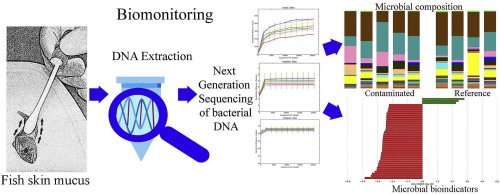当前位置:
X-MOL 学术
›
Environ. Pollut.
›
论文详情
Our official English website, www.x-mol.net, welcomes your
feedback! (Note: you will need to create a separate account there.)
A non-invasive method to monitor marine pollution from bacterial DNA present in fish skin mucus.
Environmental Pollution ( IF 7.6 ) Pub Date : 2020-04-03 , DOI: 10.1016/j.envpol.2020.114438 Diana Montenegro 1 , Carmen Astudillo-García 1 , Tony Hickey 1 , Gavin Lear 1
Environmental Pollution ( IF 7.6 ) Pub Date : 2020-04-03 , DOI: 10.1016/j.envpol.2020.114438 Diana Montenegro 1 , Carmen Astudillo-García 1 , Tony Hickey 1 , Gavin Lear 1
Affiliation

|
Marine coastal contamination caused by human activity is a major issue worldwide. The implementation of effective pollution monitoring programs, especially in coastal areas, is important and urgent. The use of biological, physiological, or biochemical measurements to monitor the impacts of pollution has garnered increasing interest, particularly for the development of new non-invasive tools to assess water pollution. Fish skin mucus is in direct contact with the marine environment, making it a favourable microenvironment for the formation of biofilm bacterial communities. In this study, we developed a non-invasive technique, sampling fish skin mucus to determine and analyse bacterial community composition using next-generation sequencing. We hypothesised that bacterial communities associated with the skin mucus of a common harbour benthic blennioid triplefin fish, Forsterygion capito, would reflect conditions of different marine environments. We detected clear differences in bacterial community alpha-diversity between contaminated and reference sites. Beta-diversity analysis also revealed differences in the bacterial community structure of the skin mucus of fish inhabiting different geographical areas. The relative abundance of different bacterial orders varied among sites, as determined by linear discriminant analysis (LDA) and effect size (LEfSe) analyses. The observed variation in bacterial community compositions correlated more strongly with variation in hydrocarbons than to various metal concentrations. Using advanced DNA sequencing technologies, we have developed a novel non-invasive, low-cost and effective tool to monitor the impacts of pollution through analysis of the bacterial communities associated with fish skin mucus.
中文翻译:

一种非侵入性方法,用于监测鱼皮粘液中存在的细菌DNA造成的海洋污染。
人类活动引起的海洋沿海污染是世界范围内的主要问题。实施有效的污染监测计划,尤其是在沿海地区,是重要且紧迫的。使用生物,生理或生化测量来监测污染的影响已引起越来越多的兴趣,特别是对于开发新的非侵入性工具来评估水污染的兴趣。鱼皮粘液与海洋环境直接接触,使其成为形成生物膜细菌群落的有利微环境。在这项研究中,我们开发了一种非侵入性技术,对鱼皮肤粘液进行采样,以使用下一代测序技术来确定和分析细菌群落组成。我们假设与常见的港湾底栖类鹰嘴三鳍鱼(Forsterygion capito)的皮肤黏液相关的细菌群落将反映不同海洋环境的状况。我们在受污染站点和参考站点之间发现了细菌群落α多样性的明显差异。Beta多样性分析还揭示了居住在不同地理区域的鱼的皮肤粘液细菌群落结构的差异。通过线性判别分析(LDA)和效应量(LEfSe)分析确定,不同细菌阶的相对丰度在位点之间有所不同。观察到的细菌群落组成的变化与碳氢化合物的变化比与各种金属浓度的相关性更强。使用先进的DNA测序技术,
更新日期:2020-04-03
中文翻译:

一种非侵入性方法,用于监测鱼皮粘液中存在的细菌DNA造成的海洋污染。
人类活动引起的海洋沿海污染是世界范围内的主要问题。实施有效的污染监测计划,尤其是在沿海地区,是重要且紧迫的。使用生物,生理或生化测量来监测污染的影响已引起越来越多的兴趣,特别是对于开发新的非侵入性工具来评估水污染的兴趣。鱼皮粘液与海洋环境直接接触,使其成为形成生物膜细菌群落的有利微环境。在这项研究中,我们开发了一种非侵入性技术,对鱼皮肤粘液进行采样,以使用下一代测序技术来确定和分析细菌群落组成。我们假设与常见的港湾底栖类鹰嘴三鳍鱼(Forsterygion capito)的皮肤黏液相关的细菌群落将反映不同海洋环境的状况。我们在受污染站点和参考站点之间发现了细菌群落α多样性的明显差异。Beta多样性分析还揭示了居住在不同地理区域的鱼的皮肤粘液细菌群落结构的差异。通过线性判别分析(LDA)和效应量(LEfSe)分析确定,不同细菌阶的相对丰度在位点之间有所不同。观察到的细菌群落组成的变化与碳氢化合物的变化比与各种金属浓度的相关性更强。使用先进的DNA测序技术,











































 京公网安备 11010802027423号
京公网安备 11010802027423号